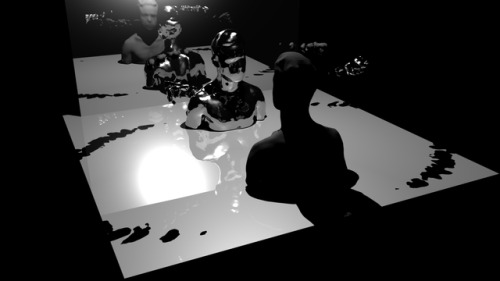#networked environments
Duplexity State (Sarah Weaver & Daniel Pinheiro, 2020)
A/V networked performance exploring the concept of ‘duplexity’.
Performed live March 10th at Experimental Intermedia Foundation (New York, US) as part of ‘Sarah Weaver: Synchrony Series, Duplexity State’ event and on March 28th online, via zoom, as part of NowNet Arts Online Performance Series [already during the COVID-19 pandemic situation].
More information about the project: https://daniel-pinheiro.tumblr.com/duplexitystate
Distant Feeling(s) is a project which aims at, once a year, bringing together different interested people, joining from their different locations in the world and share ‘15 minutes’ of togetherness across the network. Resorting to the internet as a common communication channel/medium and to video-conferencing software, everyone is invited to join and remain silent and with eyes closed during the duration of the experiment.
The usual human tools used for communication - sound and vision, commonly applied in video-conferencing - are taken out from the equation while going against everyday (technological) restlessness and enabling other senses to carefully tune into the presence of others. Distant Feeling(s) becomes an intimate portrait of people actively producing a meditative state where the screen becomes a shared and common space for all. A globally dispersed community materializing a relational system, a networked topology that not only represents the network itself, but that discusses the fragile situation of us being together while apart.
Watch video [here]
Distant Feeling(s) is a project by Annie Abrahams ( @e-stranger), Lisa Parra ( @parralis) and Daniel Pinheiro. An online [open to all] yearly reconnection, a ritual of contemplation on our situation of being together while being separated. An ever-changing re-enactment of our intra-action with and through machines.
more info:
bram.org/distantF/
landproject.tumblr.com/distantfeelings
LAND PROJECT: Placelessness (October, 2015) collaboration with Annie Abrahams: aabrahams.wordpress.com/2016/01/27/placelessness//youtu.be/tc3nxu-4nno)
// Previous sessions //
Video - Distant Feeling(s) #1 (raw version) [online, private session]: https://vimeo.com/158351502
Video - Distant Feeling(s) #2 [reSense [movement, performance, technology, art] Festival, Berlin, online, July 26th - 9h45pm - 10h45pm (GMT+2)]: https://youtube.com/watch?v=Hu8HDnXh960
Video - Distant Feeling(s) #3 [VisionS in the Nunnery, London, online, November 24th 2016 - 6h30pm (GMT)]: https://vimeo.com/193158145
Video - Distant Feeling(s) #4 [first of a yearly reconnection, online, December 1st 2017]: https://vimeo.com/245530528
Video - Distant Feeling(s) #5 [second of a yearly reconnection, online, December 19th 2018]: https://vimeo.com/308709859
Post link
Networked Topologies (Csenge Kolozsvari and Daniel Pinheiro - May / Nov 2018) - a participatory action where, by combining remote locations and individuals, it intends to explore the affordances of the networked space across, the topological movement where we register value through and with.
First developed as part of the Schizo-Somatic Workshop series and activated on May 9th, 2018 at the SenseLab at Concordia University (Montreal, CA) this project aims to explore the affordances of the networked space across and acknowledging the interruption produced by technology connecting the different nodes. This iteration focused on experimenting the collective production of a space across, under the concept of ‘collective dreaming’ suggested by Erin Manning’s propositions for collective fabulations towards social dreaming (here).
The project was shared and activated in the context of Digital Anthropologies #6 (Paris, France).
As an exercise of topological transformation of the space across, this spontaneous transvisual experience, opens doors to discuss a networked movement across within the soft flatness that characterizes the environment where it takes place where the pure flatness of the screen is shown by each person acting within the frame of the webcam and where the constraints imposed by the context render visible the ‘Joy and Sorrow of Unstable Connections’.
more info [here]
from: #NeWWWorlDisorder 7.29.2017
A 90-minute, collectively conceived, socially-broadcasted, global culture jam + net performance transmitted via Facebook Live.
Annie Abrahams, Domenico Don Barra, Michaël Systaime Borras, Curt Cloninger, Carrie Gates, Baron Lanteigne, Patrick Lichty, Randall Packer, Daniel Pinheiro, Dominik Podsiadly, Craig Saper, Paul Wong,
Hosted by Randall Packer & Michaël Systaime Borras

Day 1 and 2: After getting to know the work of all artists involved and the research projects of Motion Bank, we devised questions around ways to incorporate networked interaction for intersection between dance and webrtc technology. We looked into researching tools and different kinds of configuration for networked collaboration and performances. One idea that come up was to find ways to erase the line that splits the screen/space for a more dynamic interaction and approach. Here, we thought to provide users with features that can enhance the experience in a collaborative format while still maintaining the idea of performance as being a product of the process,that is, through the trajectory of creating, documenting and viewing.
Day 3: Daniel and I began our research by looking at possible inputs and outputs that any user would like to have available in order to establish a direct line of communication with other performing and creative technical artists whom are collaborating at a distance.
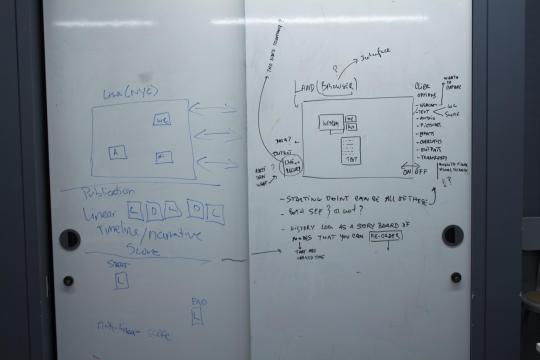
Our first exploration involved visual outputs as a representative documentation of the interaction. Olivia Jack created a webrtc slit-scan program: http://ojack.github.io/slit-scan/
The program records two users/performers moving together and outputs a visually abstract recording that fragments time in various increments (real time, slow and reverse) for the duration of the performance. The speed can be controlled by the each user.
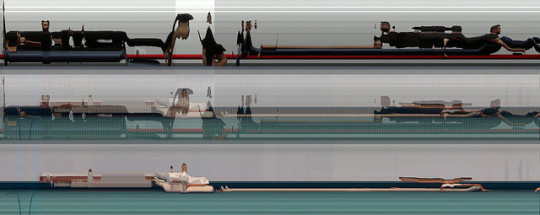
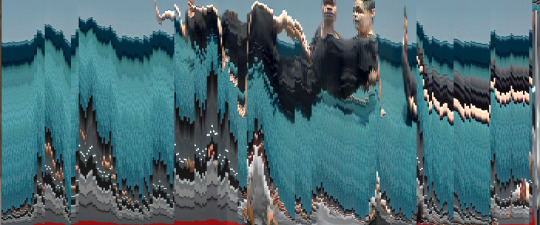
After exploring the slit-scan outcome, we realized that this program could be useful as a type of final representation of a networked performance, or movement experience. However, we thought to explore more the idea of blurring the online spaces to create a more physical/embodied interaction.
Olivia Jack then created a webrtc program called Portals: http://ojack.github.io/portals/
The program allowed us to “move together” allowing for more creating input by each user
Here Olivia (Bogotá), Lisa and Daniel (NYC) experimented moving together using Portals:
Another exploration, this time playing with light and movement (Oliva, Lisa and Daniel):
Day 4/5: In the final days and preparation for our showing, we took our experimentations of using the webrtc slit scan and portals to understand how the networked environments can be reconfigured and adapted to include more bodies, and to include an audio score to direct performers.
We collaborated with Kate Sicchio* to include her project, which involved 10 audio scores. The scores were triggered by data received from solar wind. The data is updated every minute triggering various verbal scores. The dancer/performer moves according to which scores is being dictated from the real time solar wind data.
For the final presentation we used Kate’s audio scores for performers in Bogotá (Colombia), New York (USA) and Porto (Portugal) to make a network dance/performance.
Notes/Reflection:
Here are some thoughts and reflections that arose from the experiences held while participating with LAND PROJECT at the CCL 4. Our group included Lisa Parra Daniel Pinheiro and Olivia Jack. During this time we experimented with three webrtc programs: opentok, slit scan and portal. We then shared our process with others in the group to extend our discoveries and online practice to a community of dancers and programmers to play with and explore.
Two outcomes from CCL 4:
1. Create different visual output possibilities for a networked embodiment experiences for documentation and archiving.
2. Develop a layout for communication and interaction between remote locations for collaboration and performance.
Both of these outcomes included our originally research for this project. In the last year we began using an open-source (webrtc) based platform called opentok. Opentok became ‘meeting point’ for artists to use as online space– open atelier or rehearsal space. We then introduced different inputs and outputs to visually generate and combine material that is automatically recorded and archived as it happens giving more choices to artists for possible post comments and documentation.
Although LAND PROJECT is a relationship between two distinct artists, we are interested in exploring ways to materialize our process and methodologies as a model for others to 'interact’ and share in the process itself.
Opening the process to others and combining it with the work of Olivia Jack and Kate Sicchio was definitely an important step towards an understanding of the use of these tools as a model for artistic practices. The embodiment of the other in the case of LAND PROJECT happens when the communication is established. The screen is definitely a barrier to overcome, like many other barriers that separate people. However, here the communication layout created brought many people together to interact and dance with each other. The participants, in this case, did not need to look at one another in order to feel each other’s presence. In this performance there were four location: in New York, the “green hallway” an open space that began with two performers, but throughout the performance had various people join the two original dancers; another more intimate spaces in New York was the ‘audio room’ where two males performed the scores. Other locations included performers from Portugal and Colombia. In these locations, the performers participated from a living room in one and a bedroom in the other. Language also played an important role, as not all participants understood English very well. All four locations created a performative situation linked together by sound and the internet. Here, the understanding of time and environment is where both the participant and spectators can witness the different locations and draw a multilayered narrative where ‘users’ become spectators of themselves even though they’re interacting with a group of people distributed across different time-zones and spaces.
The participation of Daniel Pinheiro in this edition of the CCL was made possible with the support of The Luso-American Development Foundation.
Hyperspace is a completely hybrid and promiscuous space where everything is intermingled and networked with everything else, a space where cultural and territorial markers have been deleted, a space marked by a total lack of distance. (…) Of course, the internet certainly has elements of hyperspace and speeds up global hyperculturization. Culture in a classic sense disappears in what is, so to speak, more cultural than culture, namely in hyperculture and in reality: as Baudrillard would put it, it disappears in what is more real than real, namely in hyper-reality. #electronicpanopticon (Byung-Chul Ha)
LAND PROJECT moves forward questioning the strong sense of everything that lacks or, in fact, moves at the rhythm of how the internet shapes the identity of a relationship based on encounters and discussions, a relationship that is lit every time onliness happens and pulls the time and space in between.
Readmore
I find it interesting that the context of the internet is what has created and shaped our relationship. There is this paradox of you being a stranger yet at the same time a close friend, that is. something more than just a collaborator. The rhythm of how we work and move together is also interesting within the notion of ‘feeling present’– I know that you are there even when you are not. (Lisa)
Aside from what drives both artists to keep interacting together, while other ideas come in to the conversations, there’s a constant movement of the bodies in relation to each other. A remote entanglement between two particles in the same stream of consciousness where the intersection of juxtapositioning flow of the natural organic coding between two human entities occurs. Out of the repetition, the meaning and significance changes every time. And in the development of an enduring system of mediated communication, the possibility of performativity of a process that loops into a continuous transformation.
it’s about the impossibility of dealing with the untranslatable and its affections… (Daniel)
The different setups that materialize, also, this project to audiences and other participants (see Performeando and Online Cooking) are fragments of an established set of guidelines that are resultant from a specific environment shaping this connection.
Ultimately, opening up the rehearsals towards an unknown, unnamed, or undefined object that contains the essence of what the connection is made of is always in relation to how two bodies place themselves in front of each other and striving to feel one another.
check our page TIMELINE:PROCESS
Distant Feeling(s) #7 | December 7th, 6PM GMT+1
Distant Feeling(s) 7th, activated on December 7th, 2019, was the third annual activation of the Distant Feeling(s) project, inviting all interested to participate in a shared moment of togetherness across a distance.
Using the internet’s potential of connectivity as a means to reflect on the constraints and limitations of that precise quality, DF has become (since its first iteration in 2015*) a participatory event in which through silence and provoking an inwards movement by the closing of the eyes while connected, which aims to highlight the relational aspect that is (supposedly) intrinsic to the idea of network. Throughout its various activations, from a closed environment between the artists Annie Abrahams, Lisa Parra and Daniel Pinheiro – where the main focus was to attempt sensing the existence and presence of the others while being physically distant, without speaking and with eyes closed – to it becoming a practice shared with an audience, and transforming into an open event since 2017, the project has addressed, cumulatively, the characteristics of the medium/infrastructure to reflect upon them, producing an archive of documentation of the various moments where each one and all work as a visual metaphor of the condition(ing) of connectivity as it is installed in our lives.
A silent, yet sentient, relational encounter, materialized as a telematic embrace where nothing seems to happen and where the lack of apparent action has transformed into the transposition of the concept of agency and a potential way for fighting alienation.
In the more recent activations of the project, a common fact has been the awareness of how machines and the surrounding environments from the different remote locations become present* while the bodies perform a sort of absentia while electricity powers this moment of communion. Where and how are we (always) while the network is functioning?
As it continues to develop, iteration after iteration, whether it is through the annual re-activations or in specific contexts it becomes clear that it is a form of researching togetherness through the internet as a way to counter its fallacy, the promise of a interconnected world where concepts of time and physical space dissipate** (an ubiquitous spatio-temporal unity), which in fact drives today the (im)possibility of collective strength/power. It is a provocation to the role of networked conversations as a practice for activism emptied from specific purpose, again, assuming the role of symbolizing a situation of engaging in different possibilities of triggering collective agency.
Can we find novelty in an already established system, and act from within, towards (an)other purpose(s)?
Distant Feeling(s) highlights in its genesis and continuity the need to feel/sense presence and suggests a pragmatical approach for reshaping a consciousness on kinship resorting to available technological tools which have been transforming its meaning.
“Silence is hard to find…” Camille Renarhd mentions at the end of DF#7 and it is through this quest for silence where machines, responsible for allowing the connection across a distance, “speak” louder and the contemporary restlessness is confronted in this model of interaction between humans and machines. It is not a proposition for a revolution nor a resolution for an evident relational crisis, it is an experience on connectivity and its fundamentals.
The relational revolution is already far along.
At the same time, it is clearly in crisis. – Time Reborn p. xxix
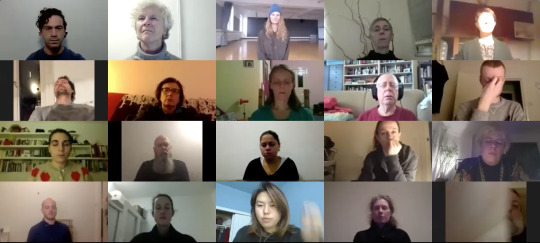
Distant Feeling(s) is a project initiated by Annie Abrahams, Lisa Parra and Daniel Pinheiro
Participants of Distant Feeling(s) #7: Camille Renarhd, Daniel Pinheiro, Muriel Piqué, Annie Abrahams, Bérénice Belpaire, Nicolaas Schmidt, Christine Develotte, Sandra Sarala, Alan Sondheim, Paul Hughes, Nerina Cocchi, Frans Van Lent, Ariane Cassimiro, Frédérique Santune, Camille Bloomfield, Jonathan Chomko, Csenge Kolozsvári, Sabrina Kwong, Ienke Kastelein, Molly Hankwitz, David Cox

OnWednesday, December 19th 2018[between2 and 2.15PM UTC],Distant Feeling(s) was activated - again, for the second time - as a participatory online happening, bringing together the artists and participants, all connecting from different remote locations through the use of the videoconferencing platform zoom.us.
Initially started as part of Lisa Parra and Daniel Pinheiro’s collaboration in LAND PROJECT, the project grew into an a specific model of interaction between the three artists involved and has been presented in different formats and contexts. Even if it can be activated outside of its yearly iteration - Distant Feeling(s) is a project which aims at, (least) once a year, bringing together different interested people, joining from their different locations in the world and share ‘15 minutes’ of togetherness across the network. Resorting to the internet as a common communication channel/medium and to video-conferencing software, everyone is invited to join and remain silent and with eyes closed during the duration of the experiment.
For this specific iteration, three different perspectives on the project emerged due to different modes of archiving/documenting the experience:
The last five minutes (editing by Annie Abrahams)
Distant Feeling(s) Gallery View
Distant Feeling(s) (recording by Alix Desaubliaux)
When the usual human tools used for communication - sound and vision, commonly applied in video-conferencing - are taken out from the equation while going against everyday (technological) restlessness and enabling other senses to carefully tune into the presence of others, Distant Feeling(s) becomes an intimate portrait of people actively producing a meditative state where the screen becomes a shared and common space for all. A globally dispersed community materializing a relational system, a networked topology that not only represents the network itself, but that discusses the fragile situation of us being together while apart.
Distant Feeling(s) #5: the fifth session of Distant Feeling(s) - the second of an online ritual of contemplation, a yearly reconnection reflecting on our situation of being together while separated.
Distant Feeling(s) is a project by Annie Abrahams ( @e-stranger), Lisa Parra ( @parralis) and Daniel Pinheiro ( @daniel-pinheiro ) - a series of online webcam meetings trying to experience each other’s presence with EYES CLOSED and NO TALKING.
info also at bram.org/distantF/
dedicated page at http://landproject.tumblr.com/distantfeelings
Distant Feeling(s) #4 - Friday December 1st 2017, 7.30 - 7.45PM (GMT+1). Online. Eyes Closed. No talking. Open to all.

15 minutes of ‘us’ being together, (t)here, where? The time between the encounters will happen from now until then what/how will it be? same people? same set up? same software?! The time in between will measure these questions and urgencies that we bring to this moment. Maybe in the future 15 minutes won’t be enough. Maybe too much?

15 minutes against the everyday digital restlessness, building a sensorial invisible fabric that gathers who’s participating (and who’s not?!), resiliently coming back to this shared moment, with the same faces or others, other possibilities of promoting a silent and blind encounter across each other in an electronic communion. Will it be ‘us’ again?!
[online recording of zoom meeting here]
[screen recording of Daniel’s desktop here]
Distant Feeling(s) #4 is the fourth session in a series of online webcam meetings trying to experience each other’s presence eyes closed and no talking.
An online ritual of contemplation on our situation of being together while being separated.
by Lisa Parra @parralis , Annie Abrahams @e-stranger , Daniel Pinheiro @daniel-pinheiro
info also at bram.org/distantF/
dedicated page at landproject.tumblr.com/distantfeelings


